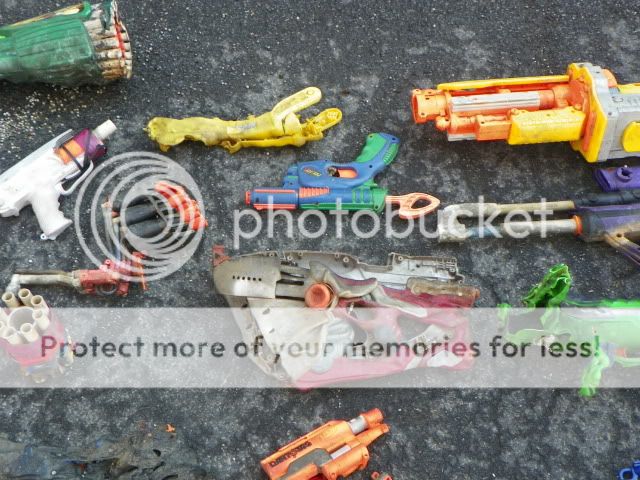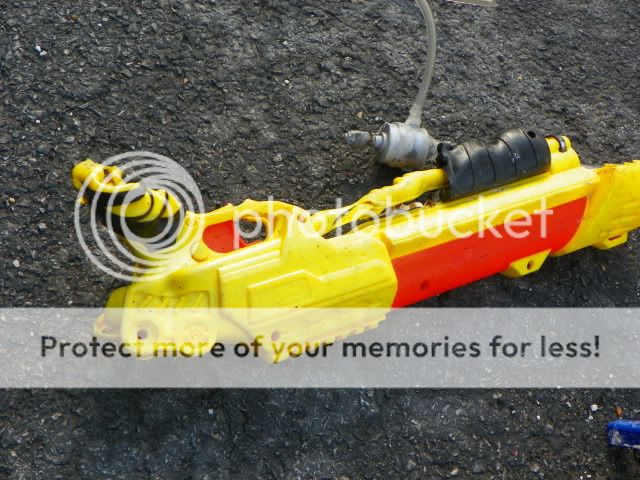
The blaster essentially operates by pulling the handle towards your body in order to prime, and pushing it away to return the handle to the forward most position and ready to fire. A strapping system is to be set up to secure the blaster to your shoulder while you push the handle forward, so that the whole blaster doesn’t move forward when you push. This design had a couple issues. 1. I hadn’t developed a viable strap yet. A simple loop would just slip off of my shoulder, causing lots of problems. Also, the blaster was longer than it had to be. The shorter the better, in this case. Thus, the redesign:

The re-model features a 2” PVC plunger tube, which allows a much shorter plunger tube length, yet yields the same (in this case even larger) air output. There is a carabiner clip at the back that clips onto the strap setup that we’ll discuss later. One of the goals of this design was to step up the PVC to 2” PVC, while still maintaining a standard sized Rainbow catch. One of the reasons for this was because I wanted to be able to mount the catch in opaque pvc. If It was made to fit 2” PVC, it would’ve been difficult to mount it properly in place. In the 1 ¼” PVC, the front edge of the catch is right at the front edge of the 1 ¼” PVC, so it’s rather easy to estimate. Anyway, let’s get to it.
Materials
-2” PVC end cap
-20.5” of 2” PVC (this can vary based on your arm length if you’d like. All that needs to remain the same is where the cuts/holes are drilled with relation to the front end of the PVC). I chose to use opaque PVC for this portion as well as for the 1.25” PVC, simply because it’s much less expensive, and I wanted to show that it could be done with said parts.
-14” of 1 ¼” PVC (See above)
-¾” thick wood (I used poplar board)
-2” PETG (9245k51 from McMaster), or you could probably use 1.5” Thin-wall PVC
-4 3/8” 6-32 set screws (McMaster part number 92311A146)
- 3/16” polycarbonate sheeting (McMaster part number 8574K27)
-¼” polycarbonate sheeting (McMaster part number 8574k28)
(You’ll only need a bit of each of the above, but if you’re starting fresh, you’ll have to buy one 12”x12” sheet of each).
- ~8 ½” of ½” round nylon rod (McMaster part number 8541k18)
- ~5” of [k26] (or [k25] I guess) spring from McMaster Carr (9637k26(25))
-2” of steel rod (McMaster part number 9120k9)
-Spring for the catch.
-Braided polyester cord from your local hardware store
-Some sort of material for a strap (~$20). I used a Camelback, which cost $50, but this is strictly optional.
-3x ½” 6-32 machine screws (McMaster part number 90272A148)
-2x 1 ¼” 6-32 machine screws (McMaster part number 90272A151)
-1x 6-32 Hex Nut (McMaster part number 90480A007)
-Skirt Seal (McMaster part number 9562k51)
-2 times ¼”x¼” round nylon spacers that fit a #6 screw
-1 1” 6-32 thread machine screw. Don’t get this from McMaster, get it from your local hardware store…I never need 1” ones, just for this application.
-A couple inches (this you’ll need to just figure by yourself, because each is different) of: ½” CPVC, ½” PVC, ½” PVC coupler, 1 ¼” Internal PVC Coupler, 1 ¼” PVC, and (2x) 1 ¼” Coupler. Here’s a pic to help:

All in all, this should come out to a total cost per blaster of ~$39.27, so about $40. This is rather good, considering that half of the cost consists of the strapping material. This could really be replaced by something as simple as an old backpack that you have around, so long as it has a chest strap. Easy peasy.
Tools that I used:
-Scroll saw
-Phillips head screw driver
-Hex Driver
-Drill/Drill bits
-Rubber mallet
-6-32 tapping bit
-Dremel (Just to cut the spring)
-Tape-measure
-Sharpie Marker (I probably use this more than anything. Red is a good color choice. It shows up clearly on all of the build materials)
-Band Saw
-Belt Sander
-Sand paper
(These tools might not all be necessary, but this is what I used throughout the build)
So anyway, let’s get to work. First things first, cut everything that you need to cut.

^Each of the rings of PVC that I mentioned earlier.

^2” of 2” PETG

^20.5” of 2” PVC, 14” of 1.25” PVC, 8.5” of ½” Nylon Rod

^3 Polycarbonate circles (Disregard one of the smaller ones). One should fit inside the skirt seal, and two should be just barely larger than the diameter of the bottom of the skirt. I don’t have specific measurements for these, simply trace them out on your polycarbonate sheet, and cut them. One of the larger and the smaller circles should have a ½” hole drilled through them, while the third should have a 5/32” hole drilled through. All should be cut from ¼” polycarbonate. I found that if the inside piece is a bit smaller, you can pinch down on it real nice with the two outside pieces.

Cut your handle. I used Ryan’s templates found here and modified them as you see.

Cut 2” from the steel rod.

Cut 5” of your [k26] spring.
Also cut the piece seen here:

Also cut the polycarbonate side plates as well as the trigger. You can find templates for both of these in Ryan’s thread as well.
And now to the more difficult bit, machining your catch. We’ll get back to those other parts later, go ahead and through them aside.
By more difficult, I don’t mean to say that it’s actually difficult to do, but it’s just a wee bit more difficult than the other pieces. Get a hold of your templates, found here.

Cut one set out, and stick it onto your ¼” polycarbonate:

Before drilling your holes, take an awl (or center punch, as some have mentioned)and tap it with a mallet onto the center of each hole-to-be. This helps to seat your drill bit more centered on the part.

Then, go ahead and drill each hole with the proper drill bit. The back plate should have a 9/16” hole for the larger hole, and 5/32” holes for the smaller ones. The other should have a ½” hole for the large one, as well as 7/64” hole for the smaller ones and should be tapped.

Here are some pics of the completed parts:

A file is your best friend here. Make sure everything is nice and clean, and fit’s the plunger rod nicely.
Here is the catch assembled with ¾” screws:




 Find content
Find content



































